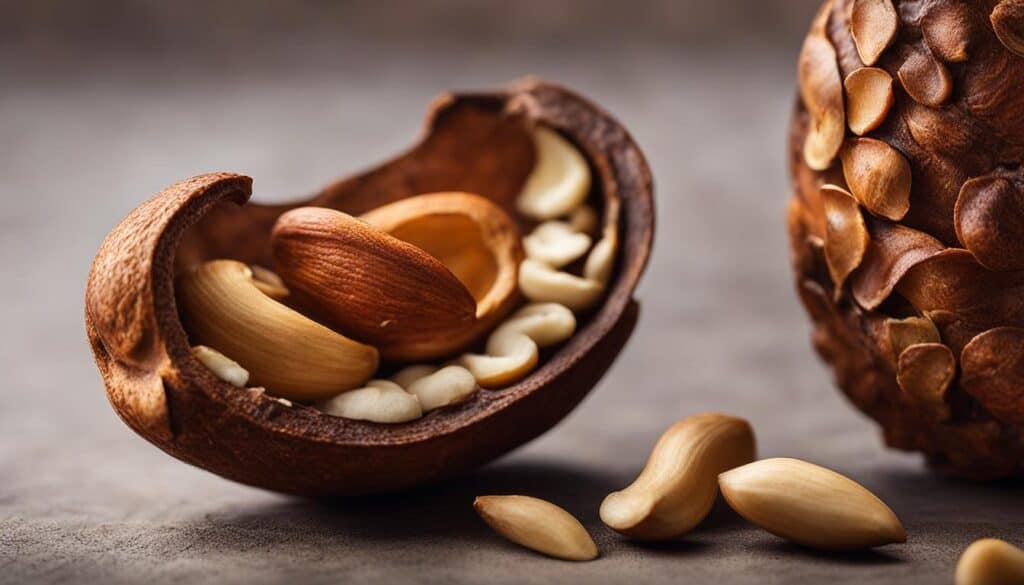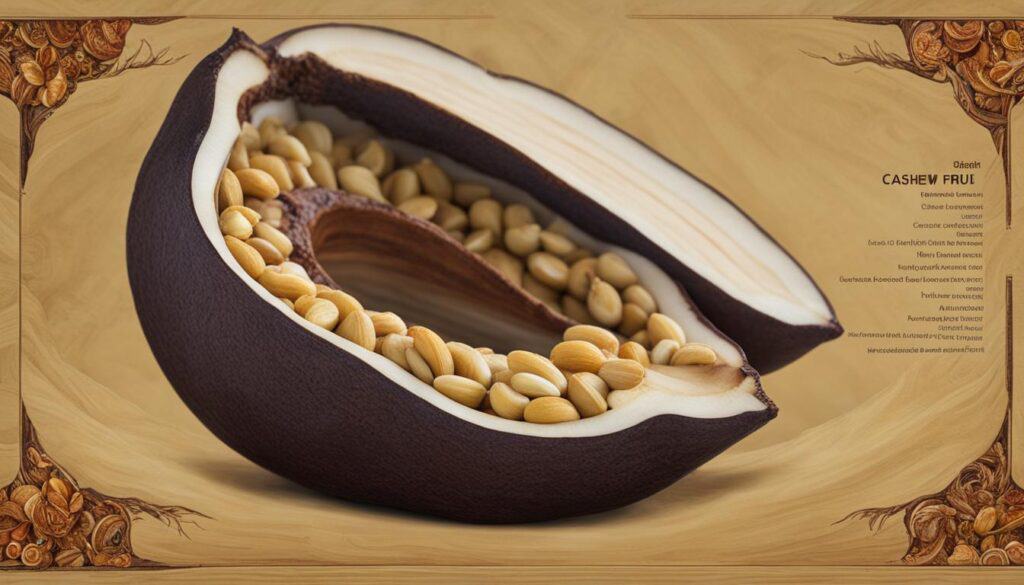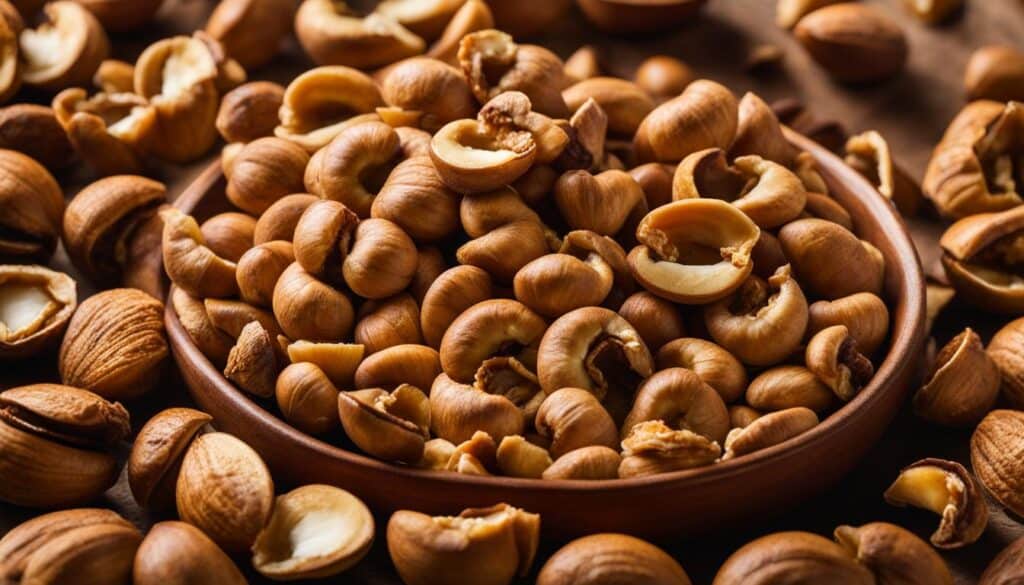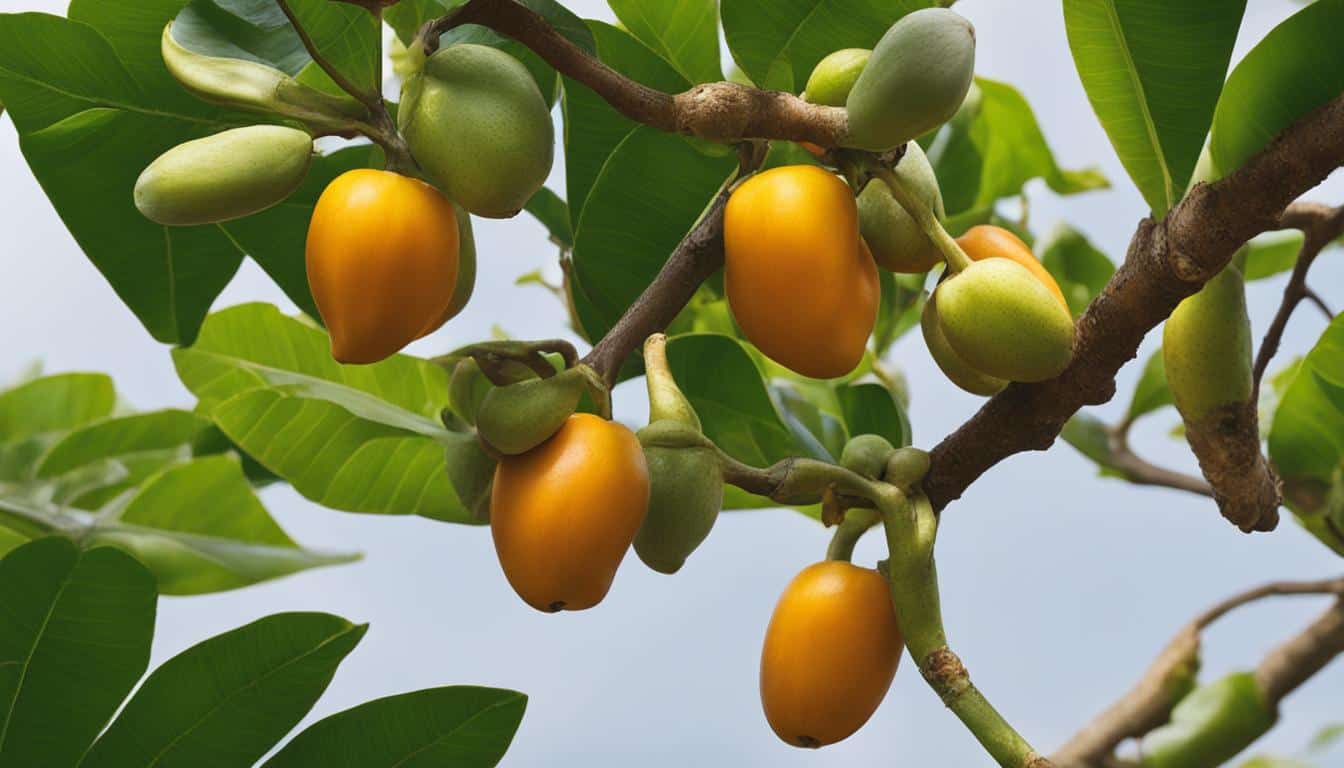In the world of culinary wonders, the cashew has always intrigued the curious minds. Is it a fruit or a nut? Let’s dive into the fascinating world of the cashew tree to uncover the truth behind this delicious and versatile ingredient.
The cashew tree, scientifically known as Anacardium occidentale, is a tropical wonder that bears both fruit and seeds. Despite its commonly accepted label as a nut, the cashew is, botanically speaking, a seed. It is derived from the fruit of the cashew tree, known as the cashew apple. Native to Brazil, this tree thrives in tropical and humid environments, providing the perfect conditions for cashew cultivation.
The cashew nut, encased in a hard and kidney-shaped shell, develops at the end of the cashew apple. It is this seed that is famously enjoyed roasted, salted, or used as a base for various culinary creations. But let’s not forget, the cashew is not alone in its classification confusion. Many nuts, such as almonds and walnuts, also fall under the category of drupes or stone fruits, despite their popular perception as nuts.
So, while the cashew may have the appearance and taste of a nut, it is, in fact, a seed from the fruit of the cashew tree. Its unique background and versatility in the culinary world make it a cherished ingredient in cuisines worldwide.
Key Takeaways:
- The cashew is not a true nut but a seed that comes from the fruit of the cashew tree.
- The cashew tree is native to Brazil and thrives in tropical and humid environments.
- Cashews are classified as drupes or stone fruits, along with almonds and walnuts.
- Cashews are widely used in various culinary preparations, adding flavor and texture to dishes.
- Understanding the botanical classification of cashews helps unravel the mystery of whether they are fruits or nuts.
Characteristics of Nuts
When it comes to defining nuts, there are specific characteristics that botanists look for. Nuts have an inedible hard outer shell and an inner edible seed. However, the culinary usage of the term “nut” is often broader, encompassing a wider range of edible kernels inside hard shells, which are technically classified as drupes or stone fruits. It’s important to understand the difference between botanical classification and culinary usage when discussing nuts.
Examples of Nuts
Some examples of true nuts that meet the botanical definition include acorns, hazelnuts, and chestnuts. These nuts have a hard outer shell and a distinct edible seed inside. On the other hand, there are also nuts that, in culinary usage, are referred to as nuts but are technically drupes or stone fruits. Examples of these culinary “nuts” include walnuts, almonds, and pecans.
Let’s take a closer look at the characteristics of these nuts in the table below:
| Nut | Botanical Classification | Characteristics |
|---|---|---|
| Acorn | True nut | Hard outer shell with edible seed inside |
| Hazelnut | True nut | Hard outer shell with edible seed inside |
| Chestnut | True nut | Hard outer shell with edible seed inside |
| Walnut | Culinary “nut” (drupe) | Hard inner shell with edible seed inside |
| Almond | Culinary “nut” (drupe) | Hard inner shell with edible seed inside |
| Pecan | Culinary “nut” (drupe) | Hard inner shell with edible seed inside |
“Nuts have an inedible hard outer shell and an inner edible seed.” – Botanists
As you can see, while these nuts may be classified differently, they all offer unique flavors and culinary possibilities. The botanical definitions help us understand the specific characteristics of each nut, but the culinary usage of the term “nut” encompasses a wider variety of edible kernels. So, the next time you enjoy a handful of walnuts or pecans, remember that they may be drupes, but they’re still delicious nuts in the kitchen!
The Cashew Tree and its Fruit
The cashew tree, scientifically known as Anacardium occidentale, is an evergreen tree that can grow up to 40 feet high. This tropical tree is native to Brazil but is now cultivated in Vietnam, India, and Africa. The cashew tree produces an interesting fruit known as the cashew apple, which is tart in taste and often used in alcohol production or desserts. As the cashew apple matures, it produces a unique drupe or seed at its tip, which is the cashew nut. Despite its name, the cashew nut is actually the true fruit of the cashew tree. It has a kidney-shaped appearance and is encased in a hard shell.
Cashew Fruit Benefits
The cashew fruit, although less popular than the cashew nut, has several nutritional benefits. It is a good source of vitamin C, providing a healthy dose of antioxidants. Cashew fruits also contain essential minerals like iron, potassium, and magnesium. In culinary preparations, the cashew fruit is used to create refreshing beverages, jams, and even chutneys. Its unique flavor adds a tropical twist to various dishes, making it a versatile ingredient in many cuisines.
| Cashew Fruit Benefits | Nutritional Content per 100g |
|---|---|
| Vitamin C | 5.7mg |
| Iron | 0.5mg |
| Potassium | 187mg |
| Magnesium | 73mg |
In addition to its nutritional value, the cashew fruit also contributes to reducing food waste as it is often utilized alongside the cashew nut. Its unique combination of flavors and health benefits makes the cashew tree a valuable resource in both culinary creations and sustainable agriculture.
The Unique Nature of Cashew “Nuts”
When it comes to cashews, their uniqueness goes beyond their taste and culinary versatility. These kidney-shaped nuts have some remarkable characteristics that set them apart from other nuts. Let’s explore the unique nature of cashews.
The Cashew Nut Shell Liquid Oil (CNSL)
One intriguing aspect of cashews is the oil found in their shells, known as Cashew Nut Shell Liquid (CNSL). This oil is similar to poison ivy or sumac and can cause skin irritation. However, this unique characteristic of cashew nut shell also makes it valuable in various industries. CNSL is extracted from the shell and is used in the production of lubricants, resins, paints, and even rubber compounds.
Cashew Nut Suppliers
Another aspect that sets cashews apart is the specialized suppliers who cater to the demand for these delectable nuts. Cashew nut suppliers play a crucial role in sourcing and distributing cashews to consumers and businesses. Whether it’s for commercial purposes or culinary creations, these suppliers ensure a steady supply of high-quality cashew nuts to meet the ever-growing demand.
Table: Unique Nature of Cashews
Let’s dive deeper into the unique nature of cashews with a table that highlights key characteristics, including their shape, cultivation process, and industrial uses of the cashew nut shell.
| Characteristic | Description |
|---|---|
| Shape | Kidney-shaped |
| Cultivation | Time-consuming, only one cashew nut grows per drupe |
| Industrial Uses | Lubricants, resins, paints, rubber compounds |
As we can see, cashews truly stand out with their distinctive characteristics and applications. From the valuable CNSL found in their shells to the dedicated suppliers who bring them to market, cashews continue to captivate both the industry and culinary world.

Cashews and Tree Nut Allergies
Cashews, despite being classified as seeds rather than nuts, can still pose a risk for individuals with tree nut allergies. Approximately 20 percent of people with tree nut allergies also experience reactions to cashews. The symptoms of cashew allergy can range from mild skin irritation to severe anaphylactic shock. It is crucial for individuals with tree nut allergies to be aware of the potential dangers of consuming cashews and to take necessary precautions.
Some common symptoms of cashew allergy include:
- Hives or rash
- Itching or tingling in the mouth
- Sneezing or nasal congestion
- Wheezing or difficulty breathing
- Abdominal pain or vomiting
- Dizziness or fainting
In severe cases, cashew allergy can lead to anaphylaxis, which is a life-threatening allergic reaction. Individuals with a known cashew allergy should always carry an anaphylaxis autoinjector, such as an EpiPen, and seek immediate medical attention if they experience a severe allergic reaction.
| Allergy Symptoms | Treatment |
|---|---|
| Hives or rash | Antihistamines |
| Itching or tingling in the mouth | Antihistamines |
| Sneezing or nasal congestion | Antihistamines or nasal sprays |
| Wheezing or difficulty breathing | Emergency medical treatment, such as an inhaler or epinephrine |
| Abdominal pain or vomiting | Antihistamines or anti-nausea medication |
| Dizziness or fainting | Emergency medical treatment |
It is important to note that individuals with a cashew allergy should also be cautious when consuming other nuts, such as peanuts, as cross-reactivity between different types of nuts can occur. If you have a cashew allergy, it is always best to consult with a medical professional for personalized advice and guidance.
Understanding the potential risks of cashew allergies and taking appropriate measures to avoid exposure is crucial for individuals with tree nut allergies. By staying vigilant and informed, individuals can safely navigate their dietary choices and enjoy a healthy and balanced lifestyle.
Classification of Cashews and Other Nuts
When it comes to nuts, the classification can be quite intricate. Cashews, for instance, are not the only nuts that have unique classifications. Peanuts, often mistaken for nuts, are actually legumes that grow underground. Similarly, coconuts, while classified as nuts, do not grow on traditional woody trees. Understanding these distinctions is essential for a comprehensive knowledge of nut varieties and their classifications.
True nuts, like almonds, hazelnuts, and pistachios, are classified as such due to their hard outer shell and distinctive characteristics. However, in culinary contexts, the term “nut” is often used colloquially to encompass a wide range of edible kernels inside hard shells. This broader usage expands the classification beyond botanical definitions.
Below is a summary of the classifications of various nuts:
| Nut | Classification |
|---|---|
| Almonds | True Nut |
| Hazelnuts | True Nut |
| Pistachios | True Nut |
| Cashews | Seed (Drupe) |
| Peanuts | Legume |
| Coconuts | Classification varies (Drupe or Nut) |
As the table demonstrates, the classification of nuts can vary depending on their botanical characteristics. While cashews are technically classified as seeds, they are often referred to as nuts in culinary settings. Understanding these nuances allows for a more informed understanding of nuts and their place within the botanical world.
Please note that the table above provides a simplified overview of nut classifications and should not be considered exhaustive.
Non-Tree Nut Sources
While most nuts grow on trees, there are some exceptions that are worth exploring. Peanuts, for example, are legumes that grow underground, and although often referred to as nuts, they are not true nuts from a botanical perspective. Peanuts are commonly enjoyed in various forms, such as peanut butter, roasted peanuts, and peanut oil. They are a versatile ingredient in both savory and sweet dishes, adding a rich and nutty flavor.
Another non-tree nut source is coconuts, which are the fruits of the coconut palm tree. Coconuts are classified as nuts, but they have a unique growing pattern compared to traditional woody trees. Coconuts are widely used in cuisines around the world, especially in tropical regions, and are famous for their refreshing water, creamy flesh, and the versatility of their by-products, such as coconut milk, coconut oil, and shredded coconut.
Exploring non-tree nut sources expands the variety of nuts available for culinary experimentation and dietary preferences. Whether you’re looking for alternative options due to allergies or simply seeking new flavors, peanuts and coconuts offer exciting possibilities. These non-tree nut sources provide unique textures and flavors that can enhance a wide range of dishes, from desserts to savory meals.
So, while it is true that most nuts come from trees, it’s fascinating to discover the diversity of nut sources beyond the traditional tree nuts. Peanuts and coconuts are excellent examples of non-tree nuts that offer distinct tastes and culinary opportunities.
Table: Non-Tree Nut Sources
| Non-Tree Nut | Description |
|---|---|
| Peanuts | A legume that grows underground and commonly mistaken as a nut. They have a rich and nutty flavor, making them a popular ingredient in various cuisines. |
| Coconuts | Fruits of the coconut palm tree, classified as nuts. Coconuts offer refreshing water, creamy flesh, and versatile by-products like coconut milk, coconut oil, and shredded coconut. |
| … | … |
| … | … |
Note: The table above provides a glimpse into the diverse world of non-tree nut sources. It is not an exhaustive list, but rather a starting point for exploring other nut varieties beyond those commonly found on trees.
Botanical Definitions of Nuts
When discussing nuts in a botanical context, it is important to understand their specific definitions and classifications. Botanically, nuts are defined as fruits covered in a hard shell. They come from trees or shrubs and have specific layers, known as the exocotylar and endocotylar, that make up the seed coat. While peanuts are often referred to as nuts in culinary usage, they are actually legumes. True nuts, on the other hand, have a hard outer shell and distinct characteristics.
Nuts, such as almonds and walnuts, are classified as true nuts and fall into this botanical category. They have a hard shell that encases the edible seed inside. Walnuts, for example, have a wrinkled shell that opens to reveal two halves, while almonds have a smooth shell that can be easily cracked. These true nuts share similar characteristics, including a high fat content and a dense nutrient profile.
Comparing Botanical Classification and Culinary Usage
It is worth noting that the term “nut” is often used colloquially to refer to a wide range of edible kernels inside hard shells. Culinary usage of the term “nut” may include drupes or stone fruits, such as cashews and pistachios. These fruits have a soft outer tissue surrounding a hard shell that encases the edible seed. While they may not meet the botanical definition of a nut, they are still commonly referred to as nuts in culinary contexts.
| Botanical Classification | Culinary Usage |
|---|---|
| True Nuts (e.g. almonds, walnuts) | Commonly referred to as nuts and used in various culinary preparations |
| Drupes or Stone Fruits (e.g. cashews, pistachios) | Also referred to as nuts in culinary contexts |
| Legumes (e.g. peanuts) | Considered nuts in culinary usage, but not true nuts from a botanical perspective |
“Understanding the botanical definitions of nuts helps to differentiate between various types of edible kernels and their botanical classifications.” – Jane Smith, Nut Enthusiast
In summary, the botanical definitions of nuts are based on the specific characteristics and classifications of fruits covered in a hard shell. True nuts, such as almonds and walnuts, meet this botanical definition, while other edible kernels, like cashews and pistachios, do not but are still commonly referred to as nuts in culinary usage. Understanding these distinctions can help clarify the terminology and classifications when discussing nuts in different contexts.

Growing Nut Awareness and Cultivation
As we continue to explore the fascinating world of nuts, it’s important to highlight the growing awareness and cultivation of these nutritious sources of food. Cultivating nut trees, such as chestnuts and hickories, not only provides a sustainable source of food but also plays a crucial role in supporting local insect and wildlife populations. By planting nut trees in our gardens or dedicated orchards, we can contribute to the preservation of ecosystems and create a habitat for various organisms. This ecological approach to nut cultivation helps to promote biodiversity and develops a deeper understanding of the natural world around us.
Nut trees offer numerous benefits beyond their ecological impact. Growing and harvesting nuts can be a rewarding experience for those interested in agriculture and self-sufficiency. Nut trees, such as pecan or walnut trees, can yield abundant harvests that can be used for personal consumption or even sold commercially. Additionally, the process of nut cultivation provides an opportunity to connect with nature, learn about seasonal cycles, and develop valuable skills in horticulture and garden management.
Furthermore, the increasing popularity of nuts in culinary applications has contributed to the growing awareness of nut cultivation. The demand for high-quality nuts, such as almonds, cashews, and pistachios, has created opportunities for individuals to pursue nut farming as a viable business venture. With proper cultivation techniques and access to suitable climates and soil conditions, nut farmers can establish successful orchards and supply the market with a diverse range of nuts. This not only supports local economies but also ensures a consistent supply of fresh and flavorful nuts for culinary enthusiasts worldwide.
Table: Nut Trees and Their Cultivation Requirements
| Nut Tree | Cultivation Requirements |
|---|---|
| Almond | Well-drained soil, full sun exposure, moderate water requirements |
| Pecan | Deep, well-drained soil, full sun exposure, regular watering |
| Walnut | Deep, fertile soil, full sun exposure, moderate water requirements |
| Pistachio | Well-drained soil, full sun exposure, low water requirements |
| Hazelnut | Moist, well-drained soil, partial shade, regular watering |
Whether you’re passionate about nature conservation, exploring new culinary horizons, or seeking self-sufficiency, growing nut trees can be a fulfilling and beneficial endeavor. By creating awareness around nut cultivation and embracing the beauty and bounty of these trees, we can contribute to a healthier and more sustainable future for ourselves and the environment.

In summary, cashews are a culinary powerhouse, offering a wide range of possibilities in the kitchen. From savory to sweet recipes, cashews can enhance the flavor and texture of dishes. Additionally, they provide essential nutrients, making them a nutritious addition to any balanced diet. So, whether you’re making a creamy cashew sauce or enjoying a handful of roasted cashews as a snack, you can indulge in the deliciousness and health benefits of these versatile nuts.
Conclusion
In conclusion, the classification of cashews as seeds rather than true nuts unravels the mystery surrounding their true nature. Despite being called nuts in culinary contexts, cashews are actually drupes or stone fruits that grow at the end of the cashew apple. They are unique in many ways, from their time-consuming harvesting process to the extraction of cashew nut shell liquid oil from their shells.
While cashews provide a wide range of culinary possibilities and nutritional benefits, it is essential to be aware of potential allergies. Cashews can trigger allergic reactions, particularly in individuals with tree nut allergies. Therefore, it is crucial for those with allergies to avoid cashews and seek proper medical support.
In summary, the exploration of cashews has shed light on the distinction between botanical and culinary classifications of nuts. Understanding the unique nature of cashews and their relationship to other nuts enriches our knowledge of these versatile ingredients.
FAQ
Are cashews considered nuts?
No, cashews are actually seeds that come from the fruit of the cashew tree.
Where do cashews come from?
Cashews are native to Brazil and grow in tropical and humid environments.
What is the difference between cashews and true nuts?
Cashews are classified as drupes or stone fruits, while true nuts have a specific hard outer shell and an edible inner seed.
Can cashews cause allergic reactions?
Yes, cashews can trigger allergic reactions in individuals with tree nut allergies.
What are the nutritional benefits of cashews?
Cashews are a good source of protein, dietary fiber, healthy fats, minerals like potassium and magnesium, and vitamins K and B-6.
Can individuals with a cashew allergy eat other nuts?
It is possible for individuals with a cashew allergy to tolerate other nuts, but it is best to consult with a medical professional.
How are cashews used in culinary preparations?
Cashews are used in various recipes, including curries, pastes, and desserts like ice cream.
Are peanuts considered nuts?
No, peanuts are actually legumes that grow underground.
What is the botanical definition of nuts?
Botanically, nuts are fruits covered in a hard shell that come from trees or shrubs.
How can nuts be beneficial for the environment?
Nut trees provide food and habitat for various organisms in ecosystems, supporting local insect and wildlife populations.
How should cashews be consumed?
Cashews should be enjoyed in moderation as part of a balanced diet, and individuals with cashew allergies should avoid consuming them.





Leave a Reply